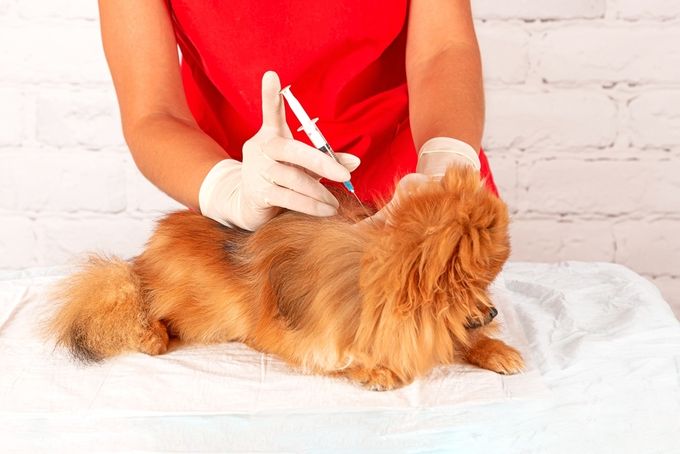Pomeranian 101: 7 Common Health Issues Owners Should Know About
Updated May 12, 2023.

Are you thinking about adding a Pomeranian to your family? These adorable, small, and outgoing dogs are perfect companions for city or suburban living and get along well with children and cats.
But before you fall head over heels for their fluffy charm, you should be aware of this breed's most common health problems. Knowing about potential health issues and watching for them will keep your dog healthy and happy, saving you trips to the vet.
Here are the seven most common health issues in Pomeranians.
- Breathing Problems
- Luxating Patella
- Hair Loss
- Back Leg Problems
- Cushing's Disease
- Cataracts
- Heart Disease
1. Breathing Problems
Pomeranians are prone to breathing issues like collapsed trachea because their necks and windpipes are so small. If the cartilage around the windpipe weakens over time, it becomes harder for your dog to breathe. Collapsed trachea in Pomeranians can be genetic or caused by a too-tight collar, which puts added pressure on the windpipe.
Reverse sneezing happens when your Pomeranian attempts to inhale air through the nose while sneezing. It can be caused by nasal irritation or anything that irritates the soft palate or throat and triggers a spasm. This is usually not a cause for concern and will stop after a few minutes.
2. Luxating Patella
Also known as slipping kneecaps, luxating patella is a common orthopedic condition in small and toy-breed dogs. It occurs when the knee cap becomes unstable and moves out of place under the tendons. As a result, the kneecap may become completely dislocated, causing pain and lameness.
If your dog is suffering from slipping kneecaps, you may notice they appear to be 'skipping' or 'hopping,' holding a leg up for several steps while running. An awkward or stiff gait is also a symptom, and surgery is often the only option to completely correct this problem.
» Wondering what common diseases can affect your dog? Find out here
3. Hair Loss
Alopecia X, a non-inflammatory hair loss, is common in plush-coated breeds like Pomeranians. The hair follicles on the body and tail stop growing, and the hair is no longer replaced after shedding. Do note that hair loss can also be a sign of hypothyroidism in Pomeranians.
Black skin disease is a type of fur loss in Pomeranians that starts with uneven patches of fur. This fur thins out, and hair loss continues until it's completely gone in those areas, leaving only exposed skin. If the dog's skin is exposed to sunlight, it can appear black, which gives the condition its name.
While it can resolve without treatment, visiting your vet is a good idea.
Affordable Peace of Mind With Metlife Pet Insurance
MetLife Pet Insurance provides the best care for your Pomeranian. Our flexible plans cover accidents, illnesses, and so much more. With 24/7 customer support and a simple claims process, you can rest assured your pet is covered.
Metlife Pet Insurance includes the following benefits:
- No-network restrictions, see any licensed vet, specialist, or emergency clinic
- Accidental or illness-related veterinary expenses coverage
- Customizable plans to suit your budget
- Preventative care coverage for routine check-ups, vaccinations etc.
- 24/7 Customer service
4. Back Leg Problems
Pomeranians are susceptible to Legg-Calve-Perthes Disease (LCP Disease), which causes the head of the rear leg bone to shrink due to reduced blood supply. The first sign is limping, usually when the puppy is 4 to 6 months old.
Other symptoms include a limp on the affected leg that begins gradually, pain, and refusal to put weight on the leg as the disease progresses.
This issue can be fixed with surgery, but the dog may have an increased likelihood of arthritis later in life.
5. Cushing's Disease
This severe health condition occurs when the adrenal glands overproduce cortisol, the 'stress' hormone. Excessive cortisol can put a dog at risk of several serious conditions, such as kidney damage or diabetes.
Symptoms of Cushing's disease include:
- Increased thirst
- Increased appetite
- Reduced activity
- Increased urination
- Excessive panting
- Thinning skin
- Reduced muscle mass
- Skin infections
- Obesity
Treatment options depend on the cause of the disease and may include medication or surgery. Your vet will examine your dog and outline a treatment plan.
6. Cataracts
Canine cataracts are one of the most common eye problems in dogs and the leading cause of blindness in older Pomeranians. Symptoms include the eyes becoming opaque and cloudy, swelling on or around the eyes, and a change in eye color.
Surgery may be needed to remove cataracts, but many dogs adapt well to vision loss.
7. Heart Disease
Pomeranians are susceptible to patent ductus arteriosus (PDA), a condition where a blood vessel in the heart fails to close after birth. PDA can cause fluid build-up in the lungs and strain on the heart. The severity of the condition depends on the size of the opening of this ductus.
Symptoms include exercise intolerance, breathing difficulties, a loud heart murmur, and abnormal pulses. In addition, dogs with PDA may sleep more than usual or be thinner than average dogs of their age and breed. The recommended treatment is usually surgery, especially in younger dogs.
Take Proper Care of Your Pomeranian
To keep your Pomeranian healthy, provide a quality diet, stay up-to-date on vaccinations, and attend routine wellness exams. You should also consider purchasing a pet insurance policy for your new pup. The best time to purchase pet insurance is when your pet is healthy. Of course, you can't predict what will happen, but you can plan ahead for the costs in case your canine companion becomes ill or injured. This way, all you have to do is enjoy your time with your new dog.










